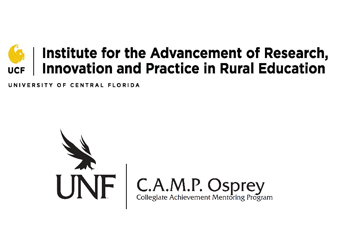 FCAN’s Assistant Director for Research and Analytics, Kimberly Lent, was recently joined by guest presenters Dr. Jerry Johnson and Dr. Hobart Harmon, Co-Directors of the Institute for the Advancement of Research, Innovation, and Practice (ARIP-RE) at UCF, and Dr. Matthew Ohlson, Assistant Professor at UNF and Director of CAMP Osprey, for a presentation about best practices to support rural student postsecondary success.
FCAN’s Assistant Director for Research and Analytics, Kimberly Lent, was recently joined by guest presenters Dr. Jerry Johnson and Dr. Hobart Harmon, Co-Directors of the Institute for the Advancement of Research, Innovation, and Practice (ARIP-RE) at UCF, and Dr. Matthew Ohlson, Assistant Professor at UNF and Director of CAMP Osprey, for a presentation about best practices to support rural student postsecondary success.
Rural Communities in Florida
The most recent census data designate 30 of Florida’s 67 counties as rural. Roughly 5% of the state’s total population and 5% of the K-12 population live in these rural counties. There is a significant difference in degree attainment between rural and non-rural counties in Florida. Approximately 23% of rural adults hold an associate’s degree or higher — this compares to 40% of adults in non-rural counties.
Federal agencies, including the United States Department of Education, measure rural differently. Using the US DOE’s method, 20 out of 67 are rural.
Trends in Rural Student Postsecondary Success
Jerry provided a brief review of research on trends in rural student postsecondary enrollment, persistence, and completion. He noted overall rural enrollment and completion rates are equal or slightly below rates for their non-rural peers, and there are no differences when factoring in income status. However, differences exist when data are disaggregated by student characteristics. Geography plays a significant role in enrollment — rural rates vary when you compare rural communities within a state and compare states. The proximity of a rural community to an urban area also influences enrollment, with those closest to urban cores having higher enrollment rates. Jerry noted there is limited information in this field about rural student persistence. The few studies conducted show little differences between rural and non-rural students.
Next, Jerry discussed barriers to rural student success, including students’ economic need (the strongest barrier), competing commitment to family and community, school factors, and student factors. Once a student enrolls in a postsecondary institution, social adjustment is the main barrier to persistence and degree completion.
Promising Practices and Strategies
Following Jerry, Hobart gave attendees an overview of two strategies that practitioners are implementing to support rural students.
The Rural Math Excel Partnership (RMEP)
Hobart’s first example was RMEP — a program created in Virginia that uses shared responsibility between families, teachers, and community-based organizations for student success in foundational math. Each of these stakeholders plays a key role to ensure students take the right math courses for success in the workforce. For example, families participated in family math nights; community organizations, such as business and nonprofits, held a career event to expose students to high-skill, high-wage career options.
This model strived to prepare students for high-skill, high-wage careers in STEM occupations and provide the baseline skills for at least a technician level job directly out of high school. Its success was dependent on the shared responsibility model that reinforced the program goals through different strategies.
Personalized Text Messages or Nudges
Researchers and organizations such as the National College Access Network have explored the use of nudge text messaging systems as a strategy to support student success. Organizations throughout the country have used text messaging nudges in a variety of ways, including to increase FAFSA completion, to increase postsecondary application submission, and to remedy financial aid verification issues.
So far, these strategies show promise for students with limited access to postsecondary resources and supports — such as rural students. Nudges also seem to be most effective for students who may be first-generation or have limited family knowledge about higher education, a common characteristic in rural families.
CAMP Osprey
Next, Matthew introduced CAMP Osprey — a leadership-mentoring program that partners University of North Florida students with K-12 students in high-poverty, rural schools across Florida. Institutions in Georgia, Texas, and North Carolina have expanded the program to communities in their states.
CAMP Osprey uses a combination of face-to-face and virtual (i.e. Skype) mentoring to help rural students become college and career ready through leadership — the top skill employers request in job candidates. The virtual component is important to the program success as it reduces program cost and overcomes geographic challenges for rural students. For example, mentor and mentee groups will go on virtual college tours.
Show Notes
To learn more about the trends in rural student postsecondary education and strategies to support student success, take advantage of these resources:
